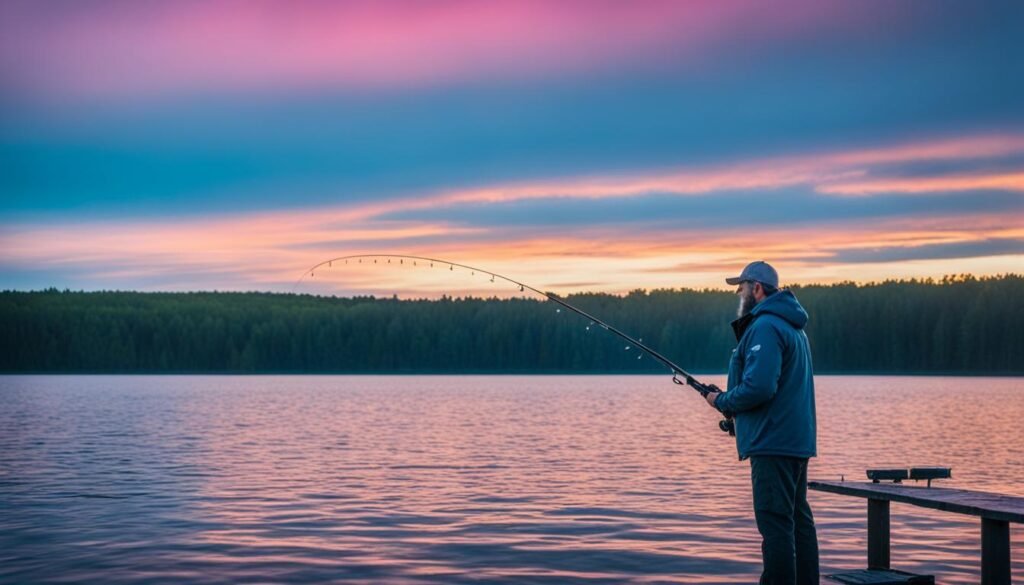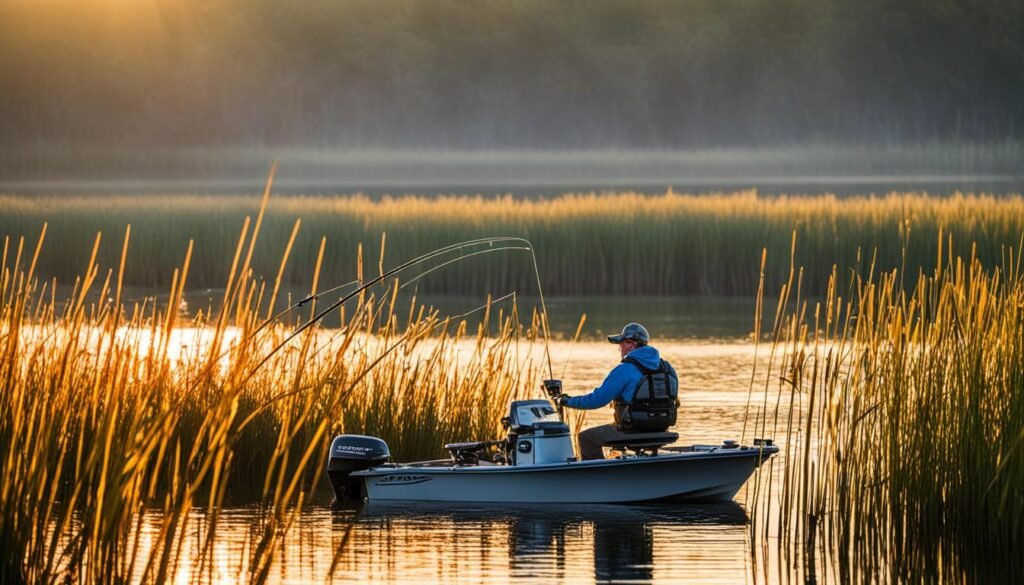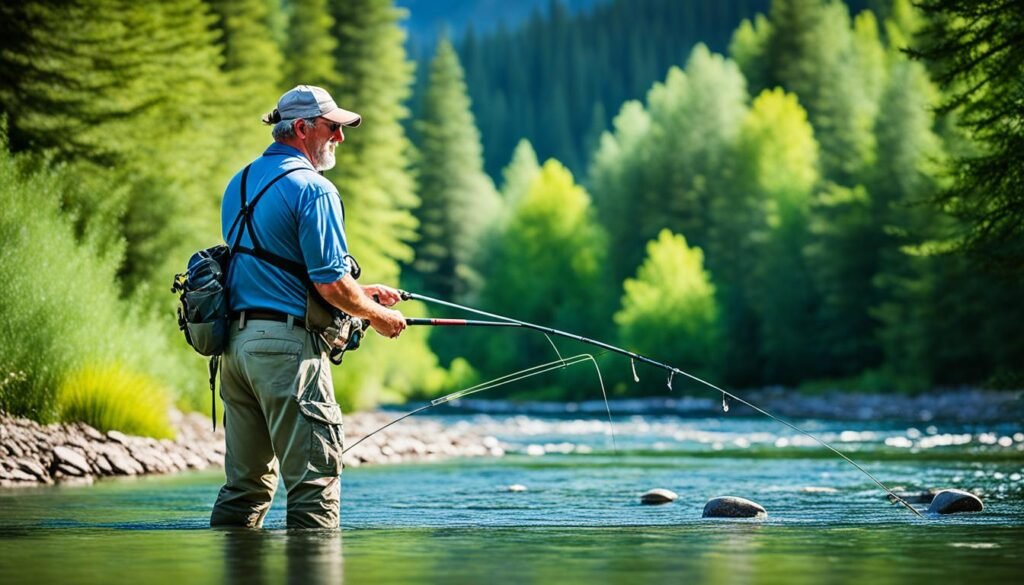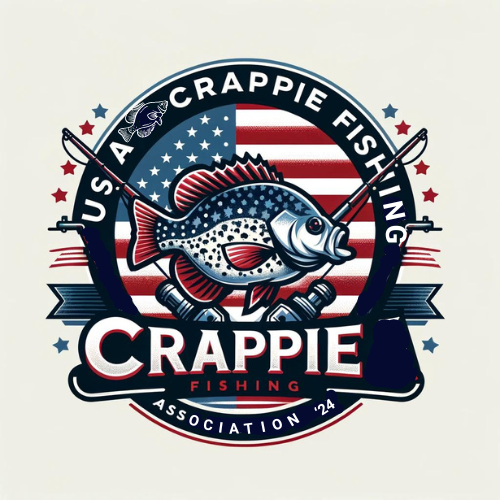When it comes to freshwater fishing, anglers are often divided over which fish reigns supreme. The battle of the freshwater giants between crappie, walleye, and trout has sparked countless debates and fishing tales. Each of these fish species possesses its own unique characteristics and appeals to different types of anglers. But which one deserves the crown as the best freshwater fish? Let’s dive into the comparison and find out.
Key Takeaways:
- Crappie, walleye, and trout are three popular freshwater fish species that attract anglers with their unique characteristics.
- Crappie, also known as panfish, are sought after for their delicious meat and exciting fights.
- Walleye, with their sharp teeth and elusive nature, pose a challenge for anglers.
- Trout, prized for their fighting abilities, are found in cold, clear streams and lakes.
- When comparing these fish, factors such as size, habitat, taste, and cooking versatility come into play.
Crappie: The Panfish Powerhouse
When it comes to freshwater angling, it’s hard to ignore the allure of crappie. Also known as panfish, crappie are highly sought after by anglers for their delicious meat and thrilling fights. Found in freshwater lakes, rivers, and reservoirs throughout North America, crappie are a staple of many fishing enthusiasts.
What sets crappie apart from other freshwater fish is their schooling behavior. These social creatures gather in large groups, making it easier for anglers to locate and target them. Crappie can be caught using various fishing techniques, including jigging, trolling, and live bait fishing.
When it comes to crappie fishing, jigs are particularly effective. Anglers can use small, colorful jigs to imitate the insects and small baitfish that crappie prey upon. The constant motion of the jig entices crappie to strike, leading to exciting battles on the water.
“Crappie are a favorite among freshwater anglers for their delicious meat and thrilling fights.”
For those who prefer trolling, using crankbaits or small spinners can attract crappie’s attention. The movement and vibration from these lures mimic the natural prey of crappie, enticing them to strike. Anglers can cover a larger area of water when trolling, increasing their chances of hooking into a school of hungry crappie.
Live bait fishing is another popular method for targeting crappie. Anglers can use minnows, worms, or even small crayfish as bait. The live bait’s natural movements and scent can attract the attention of crappie, resulting in more bites.
“Crappie’s schooling behavior makes them easier to locate and target. Using a variety of techniques such as jigging, trolling, and live bait fishing can lead to a successful day on the water.”
Whether you’re an experienced angler or just starting out, crappie fishing offers excitement and satisfaction. Their delectable meat and acrobatic fights make them a favorite among freshwater anglers. So grab your gear, find a prime crappie fishing spot, and get ready for a thrilling adventure on the water!
| Crappie | Walleye | Trout |
|---|---|---|
| Highly prized by anglers | Elusive freshwater predators | Prized sportfish |
| Schooling behavior | Sharp teeth and excellent eyesight | Acrobatic jumps and strong runs |
| Found in lakes, rivers, and reservoirs | Prefer deeper, cooler waters | Cold, oxygen-rich streams and lakes |
| Jigging, trolling, and live bait fishing | Jigging, trolling, and live bait fishing | Fly fishing, spin fishing, and bait fishing |
Walleye: The Elusive Predators
When it comes to freshwater predators, walleye are considered among the most elusive and challenging fish to catch. These elusive creatures are highly sought after by anglers for their thrilling fights and impressive size. With their sharp teeth, excellent eyesight, and ability to blend into their surroundings, walleye are true masters of stealth.
Found in various freshwater habitats such as lakes, rivers, and reservoirs, walleye offer anglers the opportunity to test their skills in different environments. Whether you’re casting your line in the calm waters of a lake or battling the currents of a river, walleye can be lurking in the depths, waiting for the perfect opportunity to strike.
To successfully target walleye, anglers employ a range of effective techniques. Jigging is a popular method that involves bouncing a lure off the bottom and enticing the fish to strike. Trolling is another favored technique, which involves dragging lures or baited lines behind a moving boat to cover a larger area of water. Live bait fishing, using minnows or worms, can also be highly productive in enticing these cunning predators.

Key Characteristics of Walleye
Here are some key characteristics that make walleye stand out:
- Sharp teeth, allowing them to capture and consume a variety of prey
- Excellent eyesight, making them adept at hunting in low-light conditions
- Blending ability, allowing them to blend effortlessly into their surroundings
- Preferred habitats include lakes, rivers, and reservoirs
- Substantial size, with specimens reaching lengths of over 30 inches
Walleye are highly prized not only for their challenging nature, but also for their delectable flesh. With their firm, white meat, walleye make for a delicious meal and are often featured on the menus of seafood restaurants.
“Walleye are often referred to as ‘marble eyes’ due to their unique eye structure, which provides them with exceptional night vision.”
| Key Features | Walleye | Crappie | Trout |
|---|---|---|---|
| Preferred Habitat | Lakes, rivers, reservoirs | Lakes, ponds, rivers | Streams, rivers, lakes |
| Average Size | Over 30 inches | 9-12 inches | Varies by species |
| Fishing Techniques | Jigging, trolling, live bait fishing | Jigging, trolling, live bait fishing | Fly fishing, spin fishing, bait fishing |
As the battle among the freshwater giants rages on, walleye continue to captivate anglers with their elusive nature and fierce determination. With their impressive size, challenging fights, and delectable flesh, walleye embody the true spirit of freshwater angling.
Trout: The Prized Sportfish
Trout are highly sought after by sportfishermen for their fighting abilities and the challenge they present. Whether you’re an experienced angler or a novice, trout fishing offers an exhilarating and rewarding experience. These elusive fish can be found in freshwater streams, rivers, and lakes with cold, clear water, making their habitats a paradise for sportfishing enthusiasts.
What sets trout apart is their acrobatic jumps and strong runs, which make them a favorite target for anglers seeking a thrilling battle. Their powerful muscles and delicate movements require skill and finesse to be successfully landed. When hooked, trout will put up a formidable fight, testing an angler’s patience and technique.
To increase your chances of success, trout can be caught using a variety of fishing techniques. Fly fishing is a popular method that allows anglers to present artificial flies that imitate natural prey, enticing trout to strike. Spin fishing, on the other hand, involves casting and retrieving lures or baits to entice the fish. Bait fishing with live bait or artificial baits is also effective in attracting trout.
The Excitement of Fly Fishing
For many avid anglers, fly fishing is considered an art form and a traditional method of fishing for trout. The beauty of fly fishing lies in the delicate presentation of the artificial fly on the water’s surface, mimicking the insects that trout feed on. This technique requires skill in casting, line management, and reading the water to lure the cautious trout. The thrill of engaging with the fish is heightened when you feel the weight of the trout on your fly rod.
Spinning Your Way to Success
If you prefer a more active and versatile approach, spin fishing is an excellent choice for targeting trout. This method involves casting and retrieving lures, such as spinners or spoons, to entice the fish to strike. Spin fishing allows anglers to cover a larger area and explore different depths of the water column, increasing their chances of a successful catch. It is a technique that combines both skill and patience.
Effective Bait Fishing Techniques
Bait fishing is a popular and reliable method for catching trout. Whether using live bait or artificial baits, the key is to present an enticing meal that will trigger the trout’s predatory instincts. Live bait such as worms or minnows can be used to tempt the fish into biting. Artificial baits, such as PowerBait or salmon eggs, can also be effective in attracting trout. The key is to experiment and find the bait that yields the best results in your fishing location.
Trout fishing is not only about the thrill of the catch, but it also allows anglers to immerse themselves in the beauty of nature. Spending a day on the banks of a serene river or lake, surrounded by breathtaking landscapes, adds to the allure of trout fishing. The tranquility and peace found in these pristine environments make the pursuit of trout a truly memorable experience.
When it comes to freshwater sportfishing, trout are undoubtedly one of the most prized species. Their strength, agility, and the challenge they present make them a coveted target for anglers of all skill levels. Whether you prefer the art of fly fishing, the versatility of spin fishing, or the reliability of bait fishing, there is a trout fishing technique that suits your style and preferences.
Fishing Techniques for Crappie
When it comes to fishing for Crappie, anglers have a variety of freshwater fishing techniques at their disposal. Understanding the preferences and behavior of crappie can significantly increase your chances of a successful fishing trip. Here are some popular methods that experienced anglers recommend:
Jigging with Small Lures or Jigs
Jigging is a popular technique for targeting crappie. Use small lures or jigs in various colors, such as minnow imitations or tube jigs. Experiment with different sizes and weights to find what works best in the specific fishing location.
Trolling with Crankbaits or Live Bait
Trolling is an effective technique for covering a larger area of water and enticing crappie to bite. Use crankbaits that mimic small fish or natural prey, or try trolling with live bait such as minnows or worms. Adjust your trolling speed to match the desired depth and crappie activity level.
Using Live Bait such as Minnows or Worms
Crappie are known to feed on live bait, making it a reliable choice for attracting them. Use small minnows or worms as bait, either on a hook or as part of a jig setup. Present the live bait near submerged structures, such as fallen trees or brush piles, where crappie are likely to seek cover.
Remember to adapt your fishing techniques based on the season, weather conditions, and the behavior of the crappie in your specific fishing location. Patience and observation are key when targeting these panfish powerhouses.

Fishing Techniques for Walleye
Fishing for walleye requires a different approach than other freshwater species. To increase your chances of success, consider the following techniques:
- Jigging with Live Bait: Walleye are known to be attracted to live bait such as minnows or leeches. Use a jigging technique by bouncing the bait off the lake or riverbed to entice a strike.
- Trolling with Crankbaits or Spinners: Cover more water by trolling with crankbaits or spinners. Adjust the speed and depth of your bait to match the walleye’s preferred feeding pattern.
- Casting with Artificial Lures: Walleye can also be caught using artificial lures such as jigs, crankbaits, or soft plastics. Experiment with different colors and sizes to find what works best in your fishing location.
When targeting walleye, it’s essential to consider factors such as water temperature, time of day, and location. Walleye are often found near rocky structures, submerged points, or drop-offs. Pay attention to their behavior and adjust your techniques accordingly.
Comparison of Walleye Fishing Techniques
| Fishing Technique | Description |
|---|---|
| Jigging with Live Bait | Bouncing live bait off the lake or riverbed to entice walleye strikes. |
| Trolling with Crankbaits or Spinners | Covering more water by towing crankbaits or spinners at varying speeds and depths. |
| Casting with Artificial Lures | Using artificial lures such as jigs, crankbaits, or soft plastics to attract walleye. |
Fishing Techniques for Trout
Trout fishing requires a strategic approach and a good understanding of the fish’s behavior and preferred habitat. These selective feeders can be challenging to catch, but with the right techniques and tactics, you can increase your chances of success.
Fly Fishing
Fly fishing is a popular and effective technique for targeting trout. It involves using lightweight artificial flies that mimic insects or small baitfish. There are three main types of fly fishing for trout:
- Dry Fly Fishing: This technique involves casting a floating fly onto the water’s surface to imitate an adult insect. The goal is to entice the trout to rise and take the fly.
- Nymph Fishing: Nymphs are underwater insect larvae that trout feed on. Nymph fishing involves using weighted flies that sink below the surface to imitate these larvae.
- Streamers: Streamers are larger, baitfish imitations that are retrieved in a way that mimics the swimming motion of injured fish. This technique is effective for targeting larger trout.
Spin Fishing
Spin fishing is another popular technique for trout fishing, especially for beginners or anglers who prefer using spinning reels and lures. Spinners and spoons are commonly used lures for targeting trout. These lures have spinning blades that create flash and vibrations to attract the fish. Some effective spin fishing techniques include:
- Casting and retrieving spinners or spoons in areas where trout are known to feed, such as riffles, eddies, or near submerged structures.
- Twitching or jerking the lure to imitate a wounded baitfish, triggering a predatory response from the trout.
- Using natural colors and sizes that closely resemble the trout’s natural prey.
Bait Fishing
Bait fishing with live bait or artificial baits can also be effective for trout. Here are some techniques to consider:
- Using live bait such as worms, minnows, or grubs on a hook with or without weights. This technique is especially effective in locations where trout are known to feed near the bottom.
- Using scented artificial baits, such as PowerBait or salmon eggs, which can attract trout by mimicking natural food sources.
- Drifting bait with the current in rivers or streams, allowing it to flow naturally and entice trout to strike.
Remember, trout are sensitive to their surroundings, so it’s important to approach fishing with finesse and patience. Pay attention to water clarity, temperature, and time of day to increase your chances of a successful trout fishing outing.

Now that you have an overview of the different techniques for trout fishing, you can choose the one that suits your preferences and the fishing conditions. Experiment with different methods, adapt to the fish’s behavior, and enjoy the thrill of hooking into a beautiful trout.
Comparison of Size and Habitat
When comparing crappie, walleye, and trout, it’s important to consider factors such as size and habitat.
Size:
| Fish Species | Average Length |
|---|---|
| Crappie | 9-12 inches |
| Walleye | Up to 30 inches or more |
| Trout | Varies by species, up to over 40 inches |
Habitat:
- Crappie: Crappie prefer clearer, calmer waters such as lakes, reservoirs, and slow-moving rivers.
- Walleye: Walleye thrive in deeper, cooler waters such as large lakes, reservoirs, and rivers.
- Trout: Trout species require cold, oxygen-rich streams and lakes with clear water.
Understanding the size and habitat preferences of crappie, walleye, and trout is crucial for successful angling. Whether you’re targeting smaller crappie in calm lakes, larger walleye in deep waters, or elusive trout in cold streams, adjusting your fishing techniques and choosing suitable locations can significantly improve your chances of a successful catch.
Taste and Cooking Versatility
For many anglers, the taste and cooking versatility of the fish are important factors to consider when deciding between crappie, walleye, and trout. Each of these freshwater fish species offers its own distinctive flavor profile and can be prepared in various mouthwatering ways.
Crappie
Crappie has a mild, sweet flavor that is highly enjoyable for seafood enthusiasts. Its tender white flesh lends itself well to different cooking methods, making it a versatile choice. Many anglers prefer to fry or bake crappie to maintain its delicate taste and flaky texture.
Walleye
Walleye is renowned for its delicate, flaky texture and mild flavor, making it a sought-after culinary treat. This fish is incredibly versatile and can be prepared in a variety of ways. Popular cooking methods for walleye include breading and frying, grilling, or baking, allowing the unique flavors to shine through.
Trout
Trout boasts a rich, buttery flavor that appeals to seafood lovers. It offers a delightful combination of taste and texture. Trout can be prepared using several cooking techniques, such as grilling, smoking, or baking, allowing the natural flavors to develop and providing a delectable dining experience.
When it comes to cooking freshwater fish, anglers have the freedom to explore various recipes and preparations. Whether you prefer the mild sweetness of crappie, the delicate flakiness of walleye, or the rich butteriness of trout, these freshwater fish species offer endless culinary possibilities for you to savor. Experimenting with different flavors and cooking methods will help you discover your favorite way to enjoy these delectable catches.
Conservation and Management Efforts
Conservation and management efforts are crucial for ensuring the long-term health and sustainability of crappie, walleye, and trout populations in freshwater ecosystems. Fisheries management agencies and organizations play a vital role in regulating fishing practices to protect these valuable fish species.
Regulating Fishing Seasons and Catch Limits:
Fisheries management agencies set fishing seasons and catch limits to prevent overfishing and maintain balanced fish populations. By implementing specific timeframes for fishing and restricting the number of fish that can be harvested, these measures help prevent excessive exploitation and ensure the continued abundance of crappie, walleye, and trout.
Size Restrictions and Slot Limits:
Size restrictions and slot limits are additional regulations used to promote sustainable fishing practices. By specifying minimum and maximum sizes for harvested fish, fisheries management agencies help protect the reproductive potential of these species. Slot limits, which define the range of permitted sizes for keeping fish, allow smaller individuals to grow and spawn, contributing to the overall health of the population.
Habitat Preservation and Restoration:
Preserving and restoring the natural habitats of crappie, walleye, and trout is essential for their survival. Fisheries management agencies collaborate with conservation organizations to conserve and improve aquatic ecosystems. This involves activities such as streambank stabilization, reforestation, and water quality improvement projects. By protecting and enhancing the habitats where these fish species reside, we can ensure their long-term viability.
“Conservation is the key to preserving the delicate balance of freshwater ecosystems and the diverse fish species they support. Through responsible fishing practices and proactive habitat conservation, we can continue to enjoy the thrill of catching crappie, walleye, and trout for generations to come.”
The Role of Anglers:
Anglers also play a vital role in fish conservation. By practicing catch and release, anglers can contribute to the sustainability of crappie, walleye, and trout populations. Returning fish to the water unharmed allows them to reproduce and contribute to the overall abundance of the species.
Education and Awareness:
Education and awareness about the importance of freshwater fish conservation are essential for fostering responsible fishing practices. Angler education programs, public outreach campaigns, and collaborations between fisheries management agencies and angling communities help promote a culture of conservation and sustainable fishing.
Fisheries management agencies and organizations, along with the collective efforts of anglers and conservationists, play a crucial role in protecting crappie, walleye, and trout populations. By implementing regulations, preserving habitats, and promoting responsible fishing practices, we can ensure the continued health and abundance of these cherished freshwater fish species for future generations to enjoy.
Popular Fishing Destinations for Freshwater Giants
Anglers seeking to battle the freshwater giants of crappie, walleye, and trout can find a plethora of popular fishing destinations. These locations offer excellent opportunities for anglers to test their skills and experience the thrill of reeling in these prized freshwater fish.
Crappie Fishing Hotspots
When it comes to crappie fishing, two notable destinations stand out: Leech Lake in Northern Minnesota and Lake of the Woods in Ontario, Canada. These lakes are renowned for their thriving crappie populations, attracting anglers from far and wide. The abundance of crappie in these waters provides ample opportunities for anglers to catch their limit and experience the excitement of hooking these panfish powerhouses.
Walleye Fishing Paradises
The Great Lakes are popular destinations for walleye enthusiasts. Lake Erie, known for its vast size and abundance of walleye, offers anglers a chance to reel in trophy-worthy catches. Another notable walleye fishing hotspot is Lake Winnebago in Wisconsin, famous for its annual ice fishing tournament and the opportunity to catch walleye all year round. These lakes attract avid walleye fishermen looking to test their skills against these elusive predators.
Famous Trout Streams
Trout enthusiasts often flock to famous trout streams that are known for their abundance of fish and beautiful surroundings. The Madison River in Montana is a prime location for fly fishing enthusiasts, offering ample opportunities to catch species such as rainbow trout and brown trout. The Au Sable River in Michigan is another popular trout fishing destination, known for its crystal-clear waters and thriving trout populations. Anglers can enjoy the challenge of casting their lines in these flowing streams and experiencing the thrill of hooking a prized trout.
Whether you’re targeting crappie, walleye, or trout, these popular fishing destinations provide a diverse range of opportunities for freshwater anglers. From picturesque lakes to meandering rivers, each location offers its unique charm and promises an unforgettable fishing experience.
Conclusion
In conclusion, the battle between crappie, walleye, and trout in the realm of freshwater fishing is subjective and depends on the individual angler’s preferences. Each species offers its own unique characteristics, challenges, and rewards, making it difficult to determine the absolute best freshwater fish. Whether you enjoy the excitement of pursuing crappie in shallow waters, the challenge of targeting elusive walleye in deep reservoirs, or the skill required to catch trout in cold streams, the world of freshwater angling offers endless opportunities for adventure and excitement.
Crappie, with their delicious meat and schooling behavior, appeal to anglers who value taste and the thrill of reeling in multiple fish at once. Walleye, known for their elusive nature and predatory instincts, attract anglers seeking a challenge and the opportunity to test their skills. Trout, celebrated for their fighting abilities and acrobatic jumps, captivate sportfishermen looking for a true battle on the water.
In the end, the best freshwater fish is the one that brings you joy, fulfillment, and a sense of accomplishment. Whether you prefer the satisfaction of landing a trophy crappie, the triumph of outsmarting a wily walleye, or the exhilaration of a leaping trout, freshwater fishing is a pursuit that can be enjoyed by anglers of all skill levels. So, grab your gear, explore different techniques, and embark on your own freshwater fishing adventure to discover your personal favorite among the crappie, walleye, and trout.
